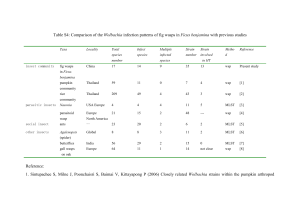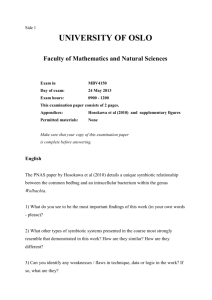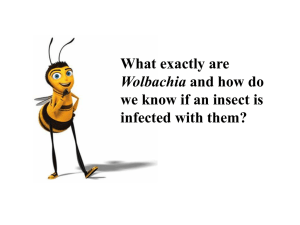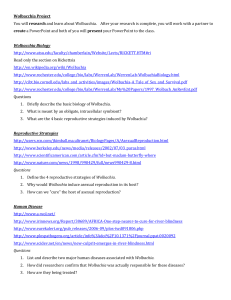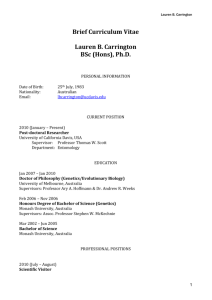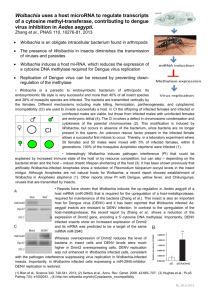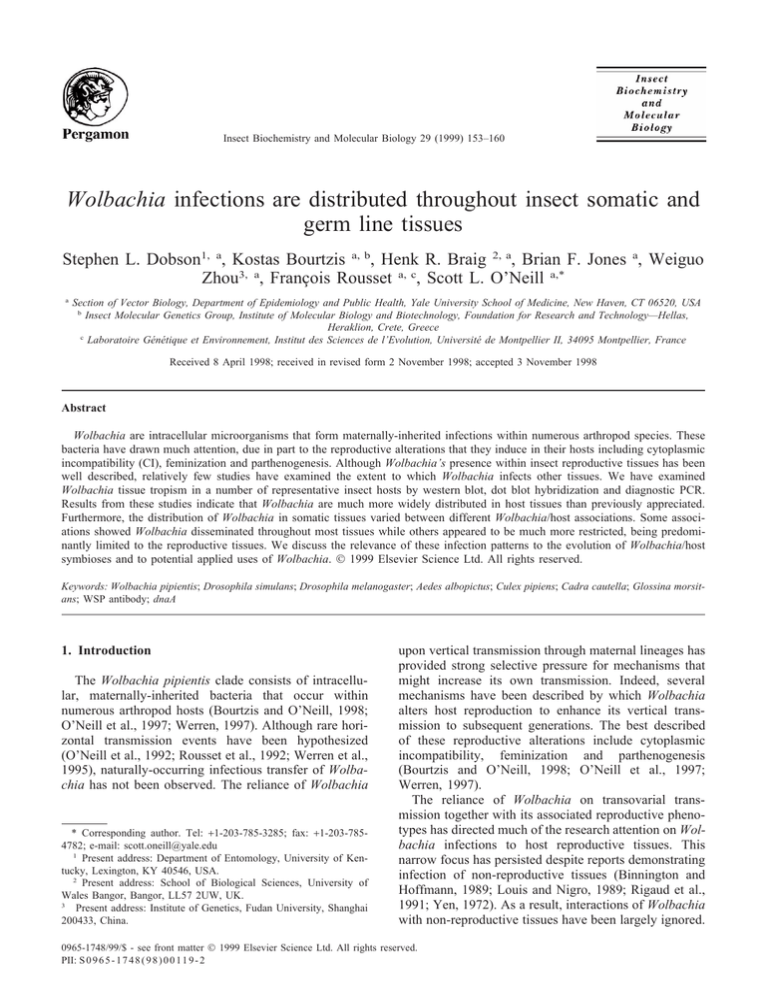
Insect Biochemistry and Molecular Biology 29 (1999) 153–160
Wolbachia infections are distributed throughout insect somatic and
germ line tissues
Stephen L. Dobson1, a, Kostas Bourtzis a, b, Henk R. Braig 2, a, Brian F. Jones a, Weiguo
Zhou3, a, François Rousset a, c, Scott L. O’Neill a,*
a
Section of Vector Biology, Department of Epidemiology and Public Health, Yale University School of Medicine, New Haven, CT 06520, USA
b
Insect Molecular Genetics Group, Institute of Molecular Biology and Biotechnology, Foundation for Research and Technology—Hellas,
Heraklion, Crete, Greece
c
Laboratoire Génétique et Environnement, Institut des Sciences de l’Evolution, Université de Montpellier II, 34095 Montpellier, France
Received 8 April 1998; received in revised form 2 November 1998; accepted 3 November 1998
Abstract
Wolbachia are intracellular microorganisms that form maternally-inherited infections within numerous arthropod species. These
bacteria have drawn much attention, due in part to the reproductive alterations that they induce in their hosts including cytoplasmic
incompatibility (CI), feminization and parthenogenesis. Although Wolbachia’s presence within insect reproductive tissues has been
well described, relatively few studies have examined the extent to which Wolbachia infects other tissues. We have examined
Wolbachia tissue tropism in a number of representative insect hosts by western blot, dot blot hybridization and diagnostic PCR.
Results from these studies indicate that Wolbachia are much more widely distributed in host tissues than previously appreciated.
Furthermore, the distribution of Wolbachia in somatic tissues varied between different Wolbachia/host associations. Some associations showed Wolbachia disseminated throughout most tissues while others appeared to be much more restricted, being predominantly limited to the reproductive tissues. We discuss the relevance of these infection patterns to the evolution of Wolbachia/host
symbioses and to potential applied uses of Wolbachia. 1999 Elsevier Science Ltd. All rights reserved.
Keywords: Wolbachia pipientis; Drosophila simulans; Drosophila melanogaster; Aedes albopictus; Culex pipiens; Cadra cautella; Glossina morsitans; WSP antibody; dnaA
1. Introduction
The Wolbachia pipientis clade consists of intracellular, maternally-inherited bacteria that occur within
numerous arthropod hosts (Bourtzis and O’Neill, 1998;
O’Neill et al., 1997; Werren, 1997). Although rare horizontal transmission events have been hypothesized
(O’Neill et al., 1992; Rousset et al., 1992; Werren et al.,
1995), naturally-occurring infectious transfer of Wolbachia has not been observed. The reliance of Wolbachia
* Corresponding author. Tel: +1-203-785-3285; fax: +1-203-7854782; e-mail: scott.oneill@yale.edu
1
Present address: Department of Entomology, University of Kentucky, Lexington, KY 40546, USA.
2
Present address: School of Biological Sciences, University of
Wales Bangor, Bangor, LL57 2UW, UK.
3
Present address: Institute of Genetics, Fudan University, Shanghai
200433, China.
upon vertical transmission through maternal lineages has
provided strong selective pressure for mechanisms that
might increase its own transmission. Indeed, several
mechanisms have been described by which Wolbachia
alters host reproduction to enhance its vertical transmission to subsequent generations. The best described
of these reproductive alterations include cytoplasmic
incompatibility, feminization and parthenogenesis
(Bourtzis and O’Neill, 1998; O’Neill et al., 1997;
Werren, 1997).
The reliance of Wolbachia on transovarial transmission together with its associated reproductive phenotypes has directed much of the research attention on Wolbachia infections to host reproductive tissues. This
narrow focus has persisted despite reports demonstrating
infection of non-reproductive tissues (Binnington and
Hoffmann, 1989; Louis and Nigro, 1989; Rigaud et al.,
1991; Yen, 1972). As a result, interactions of Wolbachia
with non-reproductive tissues have been largely ignored.
0965-1748/99/$ - see front matter 1999 Elsevier Science Ltd. All rights reserved.
PII: S 0 9 6 5 - 1 7 4 8 ( 9 8 ) 0 0 1 1 9 - 2
154
S.L. Dobson et al. / Insect Biochemistry and Molecular Biology 29 (1999) 153–160
The significance of Wolbachia infections in insect nonreproductive tissues has recently reemerged with the
description of a Wolbachia strain that forms heavy infections in nervous and muscle tissues of Drosophila and
drastically reduces the life-span of adult flies (Min and
Benzer, 1997). The potential significance of Wolbachia
infections in insect non-reproductive tissues is also supported by hemolymph transfer experiments and observations of heavy Wolbachia infections throughout isopod
tissues (Juchault et al., 1994; Rigaud et al., 1991). These
examples indicate that early assessments of Wolbachia
tissue distribution in insects may have underestimated
the extent and significance of somatic infections.
We report studies that address the tissue distribution
of several different Wolbachia/insect associations. Three
indirect assays were employed on isolated insect tissues;
PCR and dot blot hybridizations were used to detect
Wolbachia genomic DNA and a western blot assay was
used to detect a Wolbachia outer surface protein (WSP)
(Braig et al., 1998; Sasaki et al., 1998; Zhou et al., 1998).
Our results demonstrate that somatic infection by Wolbachia is a common event. In some hosts however, Wolbachia infection can only be detected in the gonads.
D. simulans Riverside males. The D. simulans Watsonville strains that were infected with wRi and wMa had
been produced via embryonic microinjection (Giordano
et al., 1995) and maintained for three years. Unless
otherwise indicated, adult insects used for dissections
were 3–7 days post eclosion. However, two month old
Aedes albopictus females were also examined by western assay. All dissections were done in STE [0.1 M
NaCl, 10 mM Tris HCl, and 1 mM EDTA (pH 8.0)]. At
least five replicate insects were examined for each assay.
Wings from Drosophila simulans Riverside, Culex pipiens Barriol (common house mosquito) and Cadra
(=Ephestia) cautella (almond moth) were cut distally so
as to not include any flight muscle. Third instar Drosophila larvae and fourth instar Cadra larvae were similarly dissected in STE for larval assays. Hemolymph
from D. simulans Riverside and Ae. albopictus Houston
(Asian tiger mosquito) was collected by puncturing the
thorax of 20 adults using a fine probe. These wounded
adults were centrifuged at 1000g for 5 minutes through a
sieve made from a microcentrifuge tube (USA/Scientific
#1405) punctured with a 27.5 gauge needle. Hemolymph
from C. cautella was collected by puncturing fourth
instar larvae and centrifuging at 80g for 15 minutes
through glass wool.
2. Materials and methods
2.2. PCR
2.1. Insect handling
The insects used in this study are listed in Table 1.
All Drosophila strains were reared under similar lowdensity conditions to minimize size differences between
individuals. The introgressed strain of D. simulans
Hawaii infected with wRi was produced via five generations of backcrossing D. simulans Hawaii females with
For the PCR assay, body segments were tested instead
of dissected tissues to reduce artifacts caused by crosscontamination of tissue samples. Body segments were
homogenized in STE with 0.4 mg/ml proteinase K. This
mixture was incubated at 56°C for one hour and heat
inactivated at 95°C for 15 minutes. Samples were
extracted with phenol/chloroform/isoamyl alcohol and
Table 1
Insect host and Wolbachia strains
Host
Wolbachiaa
Reference
D. simulans Riverside
D. simulans Hawaii
D. simulans Hawaii
D. simulans Watsonville
D. simulans Watsonville
D. simulans Coffs Harbour
D. melanogaster Canton S
D. melanogaster yw67c23
D. simulans R3A
D. mauritiana
Ae. albopictus Houston
Ae. albopictus Koh Samui
Ae. albopictus Mauritius
Cx. pipiens Barriol
C. cautella
G. morsitans morsitans
wRi
wRi
wHa
wRi
wMa
wCof
wMelCS
wMel
wNo
wMa
wAlbA+wAlbB
wAlbA
wAlbA
wPip
wCauA
wMor
(Hoffman et al., 1986)
–
(O’Neill and Karr, 1990)
(Giordano et al., 1995)
(Giordano et al., 1995)
(Hoffmann et al., 1996)
(Holden et al., 1993b)
(Bourtzis et al., 1996)
(Merçot et al., 1995)
Bloomington Stock Center #31
(Sinkins et al., 1995b)
(Sinkins et al., 1995b)
(Sinkins et al., 1995b)
(Guillemaud et al., 1997)
R. T. Carde; U. Mass, Amherst
(O’Neill et al., 1993)
a
Wolbachia strain terminology is based on Zhou et al., 1998.
S.L. Dobson et al. / Insect Biochemistry and Molecular Biology 29 (1999) 153–160
ethanol precipitated. These DNA preparations were PCR
amplified in 50 mM KCl, 10 mM Tris HCl (pH 9.0),
0.1% Triton-X 100, 2.5 mM MgCl2, 0.25 mM dNTPs,
0.5 uM ftsZ primers (Holden et al., 1993a; Sinkins et
al., 1995b) and 0.5 U Taq DNA polymerase (Promega)
in a total volume of 20 µl. Samples were denatured for
3 minutes at 94°C, cycled 35 times at 94°C, 55°C and
72°C (1 minute each), followed by a 10 minute extension
at 72°C using a PTC-200 Thermal Cycler (MJ
Research). 10 µl of each PCR was electrophoresed on
1% agarose gels, stained with ethidium bromide and visualized under ultraviolet illumination.
2.3. Dot blot hybridizations
Drosophila tissues were prepared as described for
PCR. Following heat inactivation, 50 µl of 0.8 M NaOH,
20 mM EDTA was added and the samples boiled for 10
minutes. Tissue samples were blotted using a Bio-Dot
apparatus (BioRad) onto ZetaProbe membrane (BioRad)
following the recommended protocol. Membranes were
baked at 80°C for 1 hour, hybridized and washed using
standard procedures (Church and Gilbert, 1984; Sambrook et al., 1989). A PCR amplified fragment of the
dnaA gene from Wolbachia was random labeled
(Boehringer Mannheim) with 32P and used to probe the
blots (Bourtzis et al., 1996, 1994). Labeled blots were
exposed to Transcreen MS film with an appropriate
intensifying screen (Kodak). Autoradiograms were
scanned and analyzed using the NIH Image package
(version 1.61).
155
wide spectrum of cross-reactivity with WSP from other
Wolbachia strains, the recombinant WSP from wMa was
mixed with incomplete Freund’s adjuvant and used to
boost the rabbit.
2.5. Western blots
For the western assay, dissected tissues were homogenized in 0.1 mM NaCl, 10 mM Tris HCl, 1 mM EDTA
(pH 8.0) and 10% SDS. These samples were boiled for
15 minutes, desalted and concentrated using a previously
developed method (Wessel and Flügge, 1984) with a
substitution of acetone for methanol in the last step. Proteins were electrophoresed on 12% Laemmli SDS gels
and blotted onto PVDF membranes (Immobilon-P;
Millipore) under semi-dry conditions using the Transblot
SD apparatus (BioRad) and Bjerrum and SchaferNielsen buffer (Bjerrum and Schafer-Nielsen, 1986) with
20% methanol and 0.004% SDS. Membranes were
blocked with 3% non-fat dried milk, 10 mM Tris HCl
(pH 8.0), 135 mM NaCl, 0.1% Tween 20, 0.05% sodium
azide for 45 minutes, rinsed with TBS [10 mM Tris HCl
(pH 8.0), 135 mM NaCl, 0.1% Tween 20], and incubated
with anti-WSP antibody (1:1000 in TBS). Membranes
were rinsed in TBS and incubated with anti-rabbit IgG
alkaline phosphatase conjugated antibody (Boehringer
Mannheim) diluted 1:1000 in TBS. Blots were
developed using the standard BCIP/NBT protocol
(Sambrook et al., 1989). Densitometry of western blots
was conducted as for the dot blot analysis.
2.4. Antibody generation
3. Results
The coding sequences of the mature wsp gene product
(Braig et al., 1998; Zhou et al., 1998) were separately
amplified from wRi and wMa of D. simulans Riverside
and D. mauritiana using the protocol described above.
The forward primers used were 5⬘-CGG AAT TCG ATC
CTG TTG GTC CAA TAA G-3⬘ for wRi and 5⬘-CCA
TGG ATC CTG TTG TTC CAA TAA G-3⬘ for wMa;
5⬘-TCC GCT CGA GCT AGA TCC CAG TGT CAT
G-3⬘ was used as the reverse primer for both. The amplification products were each cloned into pGEM-T
(Promega) and then subcloned into the expression vector
pET-32a (Novagen). After induction of the E. coli cultures with IPTG, each recombinant WSP protein was
separately harvested from inclusion bodies, solubilized
in urea and purified through a nickel chelating resin following the recommended protocols (Novagen). The histidine tag was removed by thrombin digestion, and the
recombinant proteins further purified by preparative
electrophoresis using the Mini Prep Cell (BioRad) under
the manufacturer’s recommended conditions. The
recombinant WSP from wRi was used to immunize a
rabbit with complete Freund’s adjuvant. To secure a
To initially examine tropism, testes and ovaries were
dissected from several Wolbachia-infected Drosophila
simulans and Drosophila melanogaster strains. Total
DNA was extracted from these gonads and the remaining
carcasses. Extracted DNA was dot blotted and probed
with the Wolbachia dnaA gene. Five replicates were
used for each Drosophila strain. As shown in Table 2,
the results demonstrate that Wolbachia genomic DNA
was detected in both reproductive and non-reproductive
tissues of each of the Drosophila strains. Comparison
showed that ovaries tended to have the highest levels,
followed by male carcasses, female carcasses, and testes.
Similar to a previous report demonstrating no significant
difference between the infection levels in gonads of
mod+resc+ and mod⫺resc+ strains (Bourtzis et al., 1998),
we did not observe any significant differences in infection levels of non-reproductive tissues between these
phenotypes.
The D. simulans Riverside strain (infected with the
wRi strain of Wolbachia) was initially selected for a
more detailed examination of Wolbachia tissue tropism.
For this analysis, specific tissues from larvae and adults
156
S.L. Dobson et al. / Insect Biochemistry and Molecular Biology 29 (1999) 153–160
Table 2
Levels of dnaA in reproductive and non-reproductive (carcass) tissues of D. simulans (Ds) and D. melanogaster (Dm) resulting from dot blot
hybridizationsa
Testes
Wolbachia
Strain
mod+resc+
wRi
wNo
wHa
wMel
mod⫺resc+
wCof
wMelCS
Host
Male carcass
s.e.m.
Ovaries
s.e.m.
s.e.m.
Female carcass
s.e.m.
Ds Riverside
Ds R3A
Ds Hawaii
Dm yw67c23
79.3
63.9
30.4
25.4
5.6
0.8
2.1
5.7
90.5
68.1
55.2
44.8
1.1
1.0
5.5
4.0
95.5
67.8
77.8
66.6
1.0
0.8
2.1
3.6
88.1
66.6
58.7
34.7
1.0
2.4
4.0
5.8
Ds Coffs Harbour
Dm Canton S
66.4
40.9
3.7
4.3
82.1
64.9
2.1
3.6
83.3
79.3
3.5
2.4
79.0
64.9
4.4
4.0
a
For each tissue, the average optical density units and standard errors represent five replicates. Levels in gonadal tissues are also reported in Bourtzis
et al. (1998).
were dissected and western blotted using an anti-WSP
antibody (Fig. 1). In adults, high levels of WSP protein
were observed in preparations of the head, thoracic
muscles, midgut, Malpighian tubules, ovaries and testes.
In addition, the super- and subesophagial ganglia were
dissected from the heads of adults and assayed. This isolated nervous tissue and the remainder of these head dissections were both observed to contain WSP (data not
shown). An analysis of the distal tips of the wings and
hemolymph extracted from adults were also found to
contain WSP. In larvae, WSP protein was again
Fig. 1. Representative composite western blot for the detection of
WSP protein in tissues from (A) Wolbachia infected and uninfected
D. simulans Riverside whole adult, (B) adults, (C) larvae and (D)
wings and hemolymph. Abbreviations include: Malpighian tubules
(“Malp. tub.”), salivary glands (“Sal. glands”), hemolymph (“Hem.”),
and not done (“nd”). For B, C, and D, only the WSP band portions
of the western blots are shown.
observed in the brains, salivary glands, midguts and fat
bodies (Fig. 1). Of the tissues assayed, the accessory
glands of adult males were the only tissues in which
WSP could not be detected. This is in agreement with
an earlier report that also observed the absence of Wolbachia in the accessory glands (Binnington and
Hoffmann, 1989). As a negative control, tissues were
examined of a D. simulans Riverside strain that had been
treated with tetracycline to remove Wolbachia (O’Neill
and Karr, 1990). No WSP bands were observed in these
tissues (Fig. 1).
Similar disseminated infection patterns were observed
in Ae. albopictus Houston, Cx. pipiens and C. cautella.
In adults, WSP protein was observed in adult heads, thoracic muscles, midguts, Malpighian tubules, ovaries and
testes (Fig. 1). In Cx. pipiens, detection of WSP in the
midguts and thoracic muscles was difficult due to the
small amounts of tissue that could be obtained. Although
at the lower limits of detection using the western blot
assay, faint bands indicating the presence of WSP were
observed in these tissues. WSP was also detected in
wings from Cx. pipiens and C. cautella and in hemolymph from adult Ae. albopictus Houston. Examination
of C. cautella larvae demonstrated WSP in the brain,
salivary glands, gut, Malpighian tubules, fat body and
hemolymph.
In Ae. albopictus Koh Samui and Ae. albopictus Mauritius adults, WSP protein was detected in the ovaries
and testes at levels lower than that observed in the Houston strain (Fig. 2). This is consistent with previous
reports indicating lower infection densities in these
strains (Sinkins et al., 1995a). WSP could not be
detected in the non-reproductive tissues by western blot.
Similarly, the PCR assay demonstrated the presence of
Wolbachia genomic DNA in the abdomens but failed to
detect Wolbachia DNA in the head or thorax. In Glossina m. morsitans females, the western blot and PCR
assay also detected WSP and Wolbachia genomic DNA
S.L. Dobson et al. / Insect Biochemistry and Molecular Biology 29 (1999) 153–160
157
Fig. 3. (A) Western blot results comparing infection levels between
three pairs of different D. simulans hosts infected with the same Wolbachia type. Each western blot consists of ten lanes; each lane represents a whole male. The first five lanes are of the host in which the
Wolbachia infection originated. The last five lanes are of the host that
has been recently infected. (B) Western blot of wMa infected D. mauritiana (first five lanes) and D. simulans Watsonville (last five lanes)
males that have been dissected into testes, midgut, salivary glands
(“Saliv. glands”), head, and the remainder. “Ds” indicates D. simulans.
Fig. 2. (A) Representative composite western blot of infections of Ae.
albopictus Koh Samui, Ae. albopictus Mauritius and G. morsitans. For
comparison, a western blot of Ae. albopictus Houston (showing
somatic infection) is also shown. (B) Typical results obtained from
PCR amplifications of Ae. albopictus Koh Samui (1–4), Ae. albopictus
Mauritius (5–8) and G. morsitans (9–12). Lanes 1, 5 and 9 are abdomens of males. Lanes 2, 6 and 10 are combined head and thorax of
males. Lanes 3, 7 and 11 are abdomens of females. Lanes 4, 8 and 12
are combined head and thorax of females.
only in the ovaries (Fig. 2). This is similar to an earlier
report in which Wolbachia infection was only detected
in the ovaries of Glossina females and not in midguts
(O’Neill et al., 1993). In G. morsitans males however,
weak levels of WSP and Wolbachia genomic DNA were
detected in the head, thorax and abdomen. To examine
the potential for host age effects on Wolbachia tissue
tropism, western assays of two month old adults of Ae.
albopictus Koh Samui and Mauritius were compared
with the results from the young adults. Results obtained
for older mosquitoes were similar to the previously
described results for young adult mosquitoes. Again,
WSP was only detected in the reproductive tissues.
To address questions concerning the potential for host
effects on Wolbachia infection levels, we compared pairs
of different Drosophila hosts infected with the same
Wolbachia strain. In each pair, one host was the origin
of the Wolbachia infection and the other host had
recently been infected by the same Wolbachia type via
injection or introgression. This comparison revealed significant differences in total levels of WSP (Fig. 3). WSP
levels of the wMa symbiont were significantly
(P⬍0.0001; t-test) higher in the transinfected D. simulans Watsonville host background (106.1±14.2 optical
density units) relative to the original D. mauritiana
infection (21.4±4.0). Similarly, significantly (P⬍0.0006)
higher WSP levels were also observed from the wRi
symbiont in the D. simulans Watsonville background
(149.6±9.8) relative to D. simulans Riverside
(108.5.1±16.8). Only a slight increase (P⬍0.02) was
found in the introgressed wRi infected D. simulans
Hawaii (126.2±26.5) relative to the originating D. simulans Riverside infection (94.1±12.9). No differences were
observed in the types of tissues in which WSP was
expressed. WSP expression was detected throughout
host tissues in each Wolbachia/host complex (Fig. 3).
4. Discussion
These results demonstrate that the WSP protein
(detected by western blot) occurs in both reproductive
and non-reproductive host tissues. This is consistent with
the results expected for Wolbachia infections extending
throughout host tissues. This broad tissue tropism is also
supported by our detection of Wolbachia genomic DNA
(detected by both dot blots and PCR) throughout host
insects. This demonstrates the somatic infection of Wolbachia in females and males of multiple Drosophila
species, Ae. albopictus Houston, Cx. pipiens Barriol, C.
cautella and in males of G. morsitans. Infected tissues
within these hosts include the brain, muscles, midgut,
salivary glands, Malpighian tubules, fat body, wings,
hemolymph, testes and ovaries. When comparing different tissues, we did not attempt to quantify the infection
levels, since any comparison of Wolbachia levels using
the western assay can not exclude the possibility that
Wolbachia’s expression of the WSP protein varies
between tissues. Thus, the differing levels detected using
158
S.L. Dobson et al. / Insect Biochemistry and Molecular Biology 29 (1999) 153–160
the western technique could result from similar numbers
of Wolbachia that are differentially expressing WSP.
Examination of Ae. albopictus Koh Samui, Ae. albopictus Mauritius, and G. morsitans females detected Wolbachia genomic DNA and WSP protein only in the gonads. While this suggests the absence of Wolbachia
infection in non-reproductive tissues, we cannot exclude
the possibility that Wolbachia infection is present at levels below detectable limits using these assays. A restriction of Wolbachia infection to the gonads in some hosts
may have contributed towards the previous reports of
insignificant infection levels of Wolbachia in the nonreproductive tissues of Cx. pipiens (Yen, 1972; Yen and
Barr, 1974). Thus the discrepancy between our observations and these earlier reports may reflect real biological differences between the Wolbachia infection patterns
of the Barriol strain examined here and the strain used
in the previous study. This variability in Cx. pipiens
infection patterns would be similar to our observed differences between different Ae. albopictus strains.
It should be noted that our report has focused on
young adults. As shown in previous reports, host age
may influence Wolbachia infection levels and tissue tropism (Binnington and Hoffmann, 1989; Bressac and
Rousset, 1993; Min and Benzer, 1997). To examine this
question, western blots of tissues from two month old
adults of Ae. albopictus Koh Samui and Ae. albopictus
Mauritius and larvae of D. simulans Riverside and C.
cautella were compared with the corresponding results
from young adults. In each case, no differences were
observed in the infection levels and tissue tropism of
these differently aged individuals. However, studies
indicate that both infection levels and tropism may
change with age in tsetse flies (S. Aksoy, personal
communication). This potential variability in the roles
to which age-related factors determine Wolbachia tissue
tropism indicates that each Wolbachia/host association
may have a unique tropism and will need to be examined separately.
Host effects were suggested by the different infection
levels observed in our comparison of Drosophila pairs
infected with the same Wolbachia type. Interestingly, the
comparison of Drosophila pairs showed lower total
infection levels in hosts with longer associations with a
Wolbachia strain. This is in contrast to earlier reports
showing lower infection levels in newly introgressed or
microinjected hosts relative to the original infection
(Boyle et al., 1993; Clancy and Hoffmann, 1997; Rousset and de Stordeur, 1994). As previously mentioned
however, we cannot exclude the possibility that these
results reflect variable WSP expression within the different host strains. The presence of host effects is also supported by the observed differences between G. morsitans
males and females. While infection was consistently
restricted to ovaries in young females, infections in similarly aged males extended throughout somatic tissues.
To address the potential for effects of Wolbachia type
on infection levels, a comparison should be made of different Wolbachia types within the same host backgrounds. We did not attempt to make this comparison
using the western blot assay due to the potential for differences in the WSP antibody’s affinity for different
Wolbachia types.
Decreased longevity in D. melanogaster associated
with the rapid replication of Wolbachia in somatic
tissues of older adults has been recently observed (Min
and Benzer, 1997). Our results demonstrate that somatic
infection occurs in several Drosophila strains, Ae. albopictus Houson, Cx. pipiens, C. cautella and in G. morsitans males. This demonstrates the need for additional
studies to detect possible virulence associated with these
other examples of Wolbachia somatic infections. Drosophila infections have been best characterized for fitness
costs associated with infection. Although these previous
studies did not examine the effect of Wolbachia infection
on host longevity, no significant fitness cost associated
with infection was detected in field populations
(Hoffmann et al., 1998, 1990; Turelli and Hoffmann,
1995). A similar absence of fitness costs were observed
in laboratory populations with the exception of D. simulans Riverside/wRi (Clancy and Hoffmann, 1997;
Hoffmann et al., 1996, 1994, 1990).
Examination of fitness effects associated with somatic
infections may also address the potential adaptive significance of Wolbachia somatic infections. For example,
somatic infections may improve the host’s fecundity
(Stolk and Stouthammer, 1995) or the vertical transmission rates of Wolbachia. Broad somatic infections
may also benefit Wolbachia by increasing opportunities
for horizontal transfer. Although cytoplasmic inheritance
through females is the most widely recognized mode of
Wolbachia transmission, phylogenetic analyses suggest
that extensive horizontal transfer between species has
occurred (O’Neill et al., 1992; Rousset et al., 1992;
Werren et al., 1995). For example, a phylogenetic comparison between an endoparasitic wasp and its fly host
show that both are infected with similar Wolbachia
types, suggesting an interspecific horizontal transfer
(Werren et al., 1995). This type of transfer would be
more likely if Wolbachia were capable of somatic infection instead of being solely limited to the reproductive
tissues.
The results presented here are significant to future
attempts at artificial horizontal transfer of Wolbachia
between insect hosts. Although Wolbachia has been successfully transferred in isopods via hemolymph transfers
(Rigaud and Juchault, 1995) or injection of homogenized
nervous tissue or fat body (Juchault et al., 1994), this
approach has not been attempted in insects due in part
to a belief that Wolbachia is restricted to the germ tissue.
Therefore, most of the previous attempts have focused
on the use of embryonic cytoplasm transfers as a means
S.L. Dobson et al. / Insect Biochemistry and Molecular Biology 29 (1999) 153–160
to move Wolbachia (Boyle et al., 1993; Braig et al.,
1994; Chang and Wade, 1994; Clancy and Hoffmann,
1997; Sinkins et al., 1995b). Our results suggest that
transfer techniques similar to those used in isopods may
provide an alternative to cytoplasmic microinjections for
some Wolbachia infections in insects.
The broad tissue tropism of Wolbachia shown in this
study suggest its potential usefulness as a gene
expression vector. Infection throughout host somatic and
germ line tissues demonstrates that Wolbachia has the
potential to deliver gene products to a variety of host
tissues. A Wolbachia-based expression system for
foreign genes would have the advantage of being generally applicable to a broad range of invertebrate taxa
(O’Neill et al., 1997). In addition, the cytoplasmic drive
mechanisms of Wolbachia might serve to spread desired
genes into host insect populations (Beard et al., 1993;
Curtis, 1992; Miller, 1992; O’Neill et al., 1997).
Acknowledgements
We would like to thank Serap Aksoy for providing
insect material and Rhoel Dingalasan for his technical
assistance. This work was supported by grants from the
National Institutes of Health (AI07404-07, AI34355,
AI40620), the McKnight foundation, the UNDP/World
Bank/WHO Special Programme for Research and Training in Tropical Diseases, and the Greek Secretariat for
Research and Technology (PENED 15774).
References
Beard, C.B., O’Neill, S.L., Tesh, R.B., Richards, F.F., Aksoy, S., 1993.
Modification of arthropod vector competence via symbiotic bacteria. Parasit. Today 9, 179–183.
Binnington, K.C., Hoffmann, A.A., 1989. Wolbachia-like organisms
and cytoplasmic incompatibility in Drosophila simulans. J. Invertebr. Path. 54, 344–352.
Bjerrum, O.J., Schafer-Nielsen, C., 1986. Buffer systems and transfer
parameters for semidry electroblotting with a horizontal apparatus.
In: Dunn, M.J. (Ed.), Electrophoresis 86. VCH, Weinheim, Germany, pp. 315–327.
Bourtzis, K., Dobson, S.L., Braig, H.R., O’Neill, S.L., 1998. Rescuing
Wolbachia have been overlooked. Nature 391, 852–853.
Bourtzis, K., Nirgianaki, A., Markakis, G., Savakis, C., 1996. Wolbachia infection and cytoplasmic incompatibility in Drosophila species. Genetics 144, 1063–1073.
Bourtzis, K., Nirgianaki, A., Onyango, P., Savakis, C., 1994. A prokaryotic dnaA sequence in Drosophila melanogaster: Wolbachia
infection and cytoplasmic incompatibility among laboratory strains.
Insect Mol. Biol. 3, 131–142.
Bourtzis, K., O’Neill, S.L., 1998. Wolbachia infections and arthropod
reproduction. Bioscience 48, 287–293.
Boyle, L., O’Neill, S.L., Robertson, H.M., Karr, T.L., 1993. Interspecific and intraspecific horizontal transfer of Wolbachia in Drosophila. Science 260, 1796–1799.
Braig, H.R., Guzman, H., Tesh, R.B., O’Neill, S.L., 1994. Replace-
159
ment of the natural Wolbachia symbiont of Drosophila simulans
with a mosquito counterpart. Nature 367, 453–455.
Braig, H.R., Zhou, W., Dobson, S.L., O’Neill, S.L., 1998. Cloning and
characterization of a gene encoding the major surface protein of
the bacterial endosymbiont Wolbachia pipientis. J. Bacteriol. 180,
2373–2378.
Bressac, C., Rousset, F., 1993. The reproductive incompatibility system in Drosophila simulans: DAPI-staining analysis of the Wolbachia symbionts in sperm cysts. J. Invertebr. Path. 61, 226–230.
Chang, N.W., Wade, M.J., 1994. The transfer of Wolbachia pipientis
and reproductive incompatibility between infected and uninfected
strains of the flour beetle, Tribolium confusum, by microinjection.
Can. J. Microbiol. 40, 978–981.
Church, G.M., Gilbert, W., 1984. Genomic sequencing. Proc. Nat.
Acad. Sci. USA 81, 1991–1995.
Clancy, D.J., Hoffmann, A.A., 1997. Behavior of Wolbachia endosymbionts from Drosophila simulans in Drosophila serrata, a novel
host. Am. Nat. 149, 975–988.
Curtis, C.F., 1992. Selfish genes in mosquitoes. Nature 357, 450.
Giordano, R., O’Neill, S.L., Robertson, H.M., 1995. Wolbachia infections and the expression of cytoplasmic incompatibility in Drosophila sechellia and D. mauritiana. Genetics 140, 1307–1317.
Guillemaud, T., Pasteur, N., Rousset, F., 1997. Contrasting levels of
variability between cytoplasmic genomes and incompatibility types
in the mosquito Culex pipiens. Proc. R. Soc. Lond. [Biol.] 264,
245–251.
Hoffmann, A.A., Clancy, D., Duncan, J., 1996. Naturally-occurring
Wolbachia infection in Drosophila simulans that does not cause
cytoplasmic incompatibility. Heredity 76, 1–8.
Hoffmann, A.A., Clancy, D.J., Merton, E., 1994. Cytoplasmic incompatibility in Australian populations of Drosophila melanogaster.
Genetics 136, 993–999.
Hoffmann, A.A., Hercus, M., Dagher, H., 1998. Population dynamics
of the Wolbachia infection causing cytoplasmic incompatibility in
Drosophila melanogaster. Genetics 148, 221–231.
Hoffmann, A.A., Turelli, M., Harshman, L.G., 1990. Factors affecting
the distribution of cytoplasmic incompatibility in Drosophila simulans. Genetics 126, 933–948.
Hoffmann, A.A., Turelli, M., Simmons, G.M., 1986. Unidirectional
incompatibility between populations of Drosophila simulans. Evolution 40, 692–701.
Holden, P.R., Brookfield, J.F.Y., Jones, P., 1993a. Cloning and characterization of an ftsZ homologue from a bacterial symbiont of Drosophila melanogaster. Mol. Gen. Genet. 240, 213–220.
Holden, P.R., Jones, P., Brookfield, J.F., 1993b. Evidence for a Wolbachia symbiont in Drosophila melanogaster. Genetic Research 62,
23–29.
Juchault, P., Frelon, M., Bouchon, D., Rigaud, T., 1994. New evidence
for feminizing bacteria in terrestrial isopods: evolutionary implications. C. R. Acad. Sci. Paris 317, 225–230.
Louis, C., Nigro, L., 1989. Ultrastructural evidence of Wolbachia rickettsiales in Drosophila simulans and their relationships with unidirectional cross incompatibility. J. Invertebr. Path. 54, 39–44.
Merçot, H., Llorente, B., Jacques, M., Atlan, A., Montchamp-Moreau,
C., 1995. Variability within the Seychelles cytoplasmic incompatibility system in Drosophila simulans. Genetics 141, 1015–1023.
Miller, L.H., 1992. The challenge of malaria. Science 257, 36–37.
Min, K.-T., Benzer, S., 1997. Wolbachia, normally a symbiont of Drosophila, can be virulent, causing degeneration and death. Proc. Nat.
Acad. Sci. USA 94, 10792–10796.
O’Neill, S.L., Giordano, R., Colbert, A.M., Karr, T.L., Robertson,
H.M., 1992. 16S rRNA phylogenetic analysis of the bacterial endosymbionts associated with cytoplasmic incompatibility in insects.
Proc. Nat. Acad. Sci. USA 89, 2699–2702.
O’Neill, S.L., Gooding, R.H., Aksoy, S., 1993. Phylogenetically distant
symbiotic microorganisms reside in Glossina midgut and ovary
tissues. Med. Vet. Ent. 7, 377–383.
160
S.L. Dobson et al. / Insect Biochemistry and Molecular Biology 29 (1999) 153–160
O’Neill, S.L., Hoffmann, A.A., Werren, J.H., 1997. Influential Passengers: Inherited microorganisms and arthropod reproduction, Oxford
University Press, Oxford.
O’Neill, S.L., Karr, T.L., 1990. Bidirectional incompatibility between
conspecific populations of Drosophila simulans. Nature 348,
178–180.
Rigaud, T., Juchault, P., 1995. Success and failure of horizontal transfers of feminizing Wolbachia endosymbionts in woodlice. J. Evol.
Bio. 8, 249–255.
Rigaud, T., Souty-Grosset, C., Raimond, R., Mocquard, J., Juchault,
P., 1991. Feminizing endocytobiosis in the terrestrial crustacean
Armadillidium vulgare Latr. (Isopoda): recent acquisitions. Endocytobiosis and Cell Research 7, 259–273.
Rousset, F., Bouchon, D., Pintureau, B., Juchault, P., Solignac, M.,
1992. Wolbachia endosymbionts responsible for various alterations
of sexuality in arthropods. Proc. R. Soc. Lond. [Biol.] 250, 91–98.
Rousset, F., De Stordeur, E., 1994. Properties of Drosophila simulans
strains experimentally infected by different clones of the bacterium
Wolbachia. Heredity 72, 325–331.
Sambrook, J., Fritsch, E.F., Maniatis, T., 1989. Molecular Cloning—
A Laboratory Manual, 2nd ed. Cold Spring Harbor Laboratory
Press, Cold Spring Harbor, NY.
Sasaki, T., Braig, H.R., O’Neill, S.L., 1998. Analysis of Wolbachia
protein synthesis in Drosophila in vivo. Insect Mol. Biol. 7,
101–105.
Sinkins, S.P., Braig, H.R., O’Neill, S.L., 1995a. Wolbachia pipientis:
bacterial density and unidirectional cytoplasmic incompatibility
between infected populations of Aedes albopictus. Exp. Parasit. 81,
284–291.
Sinkins, S.P., Braig, H.R., O’Neill, S.L., 1995b. Wolbachia superinfections and the expression of cytoplasmic incompatibility. Proc. R.
Soc. Lond. [Biol.] 261, 325–330.
Stolk, C., Stouthammer, R., 1995. Influence of a cytoplasmic incompatibility-inducing Wolbachia on the fitness of the parasitoid wasp
Nasonia vitripennis. Proceedings of the Section Experimental and
Applied Entomology of the Netherlands Entomological Society 7,
33–37.
Turelli, M., Hoffmann, A.A., 1995. Cytoplasmic incompatibility in
Drosophila simulans: dynamics and parameter estimates from natural populations. Genetics 140, 1319–1338.
Werren, J.H., 1997. Biology of Wolbachia. Ann. Rev. Ent. 42, 587–
609.
Werren, J.H., Zhang, W., Guo, L.R., 1995. Evolution and phylogeny
of Wolbachia: reproductive parasites of arthropods. Proc. R. Soc.
Lond. [Biol.] 261, 55–63.
Wessel, D., Flügge, U.I., 1984. A method for the quantitative recovery
of protein in dilute solution in the presence of detergents and lipids.
Anal. Biochem. 138, 141–143.
Yen, J.H., 1972. The microorganismal basis of cytoplasmic incompatibility in the Culex pipiens complex. PhD thesis, University of California, Los Angeles.
Yen, J.H., Barr, A.R., 1974. Incompatibility in Culex pipiens. In: Pal,
R., Whitten, M.J. (Eds.), The use of genetics in insect control.
Elsevier, North Holland, pp. 315–327.
Zhou, W., Rousset, F, O’Neill, S., 1998. Phylogeny and PCR based
classification of Wolbachia strains using wsp gene sequences. Proc.
R. Soc. Lond. [Biol.] 265, 509–515.

